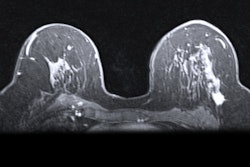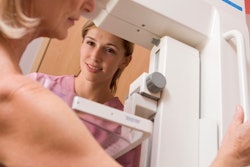
MRI screening every four years is about 12% more cost-effective than mammography every two years for women with dense breasts, according to Dutch research published September 29 in the Journal of the National Cancer Institute.
While that number may seem small, MRI was also found to be able to gain about twice as many quality-adjusted life years (QALY) over mammography, wrote a team led by Dr. H. Amarens Geuzinge from the Erasmus University Medical Center in Rotterdam, Netherlands.
"Of course, it is important to use the appropriate screening modality for the appropriate women to have the optimal benefit of screening for all women," said co-author Eveline Heijnsdijk, PhD, from the center to AuntMinnie.com. "At the same time, since health resources are limited, cost can't be ignored."
About one in 10 women have extremely dense breasts, and current mammography screening guidelines do not recommend additional imaging tests unless there is a strong family history or genetic risk for breast cancer.
Women with dense breasts have increased risk of developing breast cancer. Mammography tends to be inaccurate in detecting cancers in dense breasts due to the dense tissue absorbing more radiation. MRI has shown to be better at detecting breast cancer in such women, but it is more expensive.
The Dutch team wanted to evaluate the cost-effectiveness of several screening strategies that included additional MRI screening for women with extremely dense breast tissue.
The researchers used a microsimulation model to simulate several screening protocols containing mammography and MRI to estimate long-term effects and costs. Data came from 40,373 women ages 50 to 75 who were in the Dense Tissue and Early Breast Neoplasm Screening (DENSE) trial.
The study authors found that screening every two years with mammography alone was found to have the lowest total costs and the lowest number of QALYs compared with all other screening strategies. While mammography every two years resulted in about 50 QALYs gained, MRI every four years saw about 100 QALYs gained.
MRI alone was efficient with various screening intervals, but lengthening the intervals resulted in lower total costs and only a few cancers not being detected. MRI every four years had the highest acceptable incremental cost-effectiveness ratio with 15,620 euros ($18,250) per QALY. Screening every three years with MRI alone resulted in a ratio of 37,181 euros ($43,440) per QALY.
Study authors also wrote that if people are willing to pay more than 22,000 euros ($25,700) per QALY gained, MRI every two or three years can also become cost-effective.
However, they also said that women who know they have extremely dense breasts and elevated breast cancer risk may want to be screened more than once every four years.
Despite the promise of breast MRI in Europe, Heijnsdijk told AuntMinnie.com that translating the results to the U.S. is more difficult, citing the differences in cost.
"In the U.S., both the costs for mammography and MRI are higher than in the Netherlands, but the costs of MRI are relatively much higher. Therefore, probably MRI screening will be less cost-effective than the published cost-effectiveness for the Netherlands," Heijnsdijk said. "At the same time, also the threshold for cost-effectiveness is usually set at a higher level in the U.S. ($100,000), so it is probably still below the threshold."
Study authors wrote technological developments, such as artificial intelligence and abbreviated MRI, should be more widely available in the future, which could reduce false-positive diagnoses as well as acquisition and reading time.
"Therefore, we expect MRI screening to become less expensive in the future," they said.



















